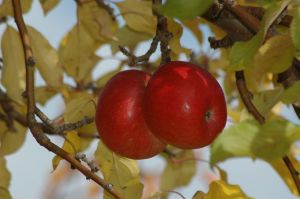21
Sep
2012
Pruning Fruit Trees…

Trees respond very differently to dormant and summer pruning. Dormant pruning is an invigorating process. During the fall, energy is stored primarily in the trunk and root system to support the top portion of the tree. If a large portion of the tree is removed during the winter, while the tree is dormant, the tree’s energy reserve is unchanged. In the spring, the tree responds by producing many new vigorous, upright shoots, called water sprouts, which shade the tree and inhibit proper development. Heavy dormant pruning also promotes excessive vegetative vigor, which uses much of the tree’s energy, leaving little for fruit growth and development.
Historically, much of the vigorous, upright vegetative growth has been removed during the dormant season; heavy dormant pruning results in a yearly cycle with excessive vegetative growth and little or no fruit production.
Timing of dormant pruning is critical. Pruning should begin as late in the winter as possible to avoid winter injury. Apple and pecan trees should be pruned first, followed by cherry, peach, and plum trees. A good rule to follow is to prune the latest blooming trees first and the earliest blooming last. Another factor to consider is tree age. Within a particular fruit type, the oldest trees should be pruned first. Younger trees are more prone to winter injury from early pruning.
Summer pruning eliminates an energy or foodproducing portion of the tree and results in reduced tree growth. Pruning can begin as soon as the buds start to grow, but it is generally started after vegetative growth is several inches long. For most purposes, summer pruning should be limited to removing the upright and vigorous current season’s growth; only thinning cuts should be used. To minimize the potential for winter injury, summer pruning should not be done after the end of July.
http://ow.ly/i/Wq1V
Autumn is a second spring….
Autumn is a second spring when every leaf is a flower. ~Albert Camus http://ow.ly/i/WpUv
A great fall snack for you and the kids.
A great fall snack for you and the kids. For the football game, running to cross-country, or trying get the 5 a day… http://ow.ly/dLyWM
Do you have any other healthy fall snack suggestions?


